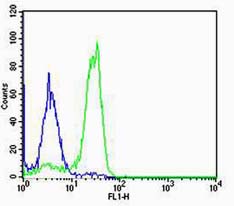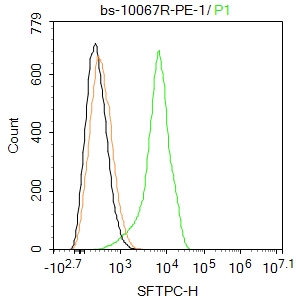
Rabbit Anti-SFTPC antibody
PSP C; PSPC; Pulmonary surfactant apoprotein 2; pulmonary surfactant apoprotein PSP C; pulmonary surfactant associated protein C; pulmonary surfactant associated proteolipid SPL pVal; Pulmonary surfactant associated proteolipid SPL(Val); SFTP 2; SFTP2; SP
View History [Clear]
Details
Product Name SFTPC Chinese Name 肺表面活性蛋白C抗体 Alias PSP C; PSPC; Pulmonary surfactant apoprotein 2; pulmonary surfactant apoprotein PSP C; pulmonary surfactant associated protein C; pulmonary surfactant associated proteolipid SPL pVal; Pulmonary surfactant associated proteolipid SPL(Val); SFTP 2; SFTP2; SP-C; SFTPC surfactant pulmonary associated protein C; SP 5; SP C; SP5; SPC; surfactant associated protein pulmonary 2; Surfactant protein c; Surfactant pulmonary associated protein C; PSPC_HUMAN. literatures Research Area Cell biology immunology Cell Surface Molecule Immunogen Species Rabbit Clonality Polyclonal React Species Human, (predicted: Mouse, Rat, Cow, Rabbit, Sheep, ) Applications ELISA=1:5000-10000 Flow-Cyt=1μg/Test
not yet tested in other applications.
optimal dilutions/concentrations should be determined by the end user.Theoretical molecular weight 4/21kDa Cellular localization Extracellular matrix Secretory protein Form Liquid Concentration 1mg/ml immunogen KLH conjugated synthetic peptide derived from human SFTPC: 24-58/197 Lsotype IgG Purification affinity purified by Protein A Buffer Solution 0.01M TBS(pH7.4) with 1% BSA, 0.03% Proclin300 and 50% Glycerol. Storage Shipped at 4℃. Store at -20 °C for one year. Avoid repeated freeze/thaw cycles. Attention This product as supplied is intended for research use only, not for use in human, therapeutic or diagnostic applications. PubMed PubMed Product Detail This gene encodes the pulmonary-associated surfactant protein C (SPC), an extremely hydrophobic surfactant protein essential for lung function and homeostasis after birth. Pulmonary surfactant is a surface-active lipoprotein complex composed of 90% lipids and 10% proteins which include plasma proteins and apolipoproteins SPA, SPB, SPC and SPD. The surfactant is secreted by the alveolar cells of the lung and maintains the stability of pulmonary tissue by reducing the surface tension of fluids that coat the lung. Multiple mutations in this gene have been identified, which cause pulmonary surfactant metabolism dysfunction type 2, also called pulmonary alveolar proteinosis due to surfactant protein C deficiency, and are associated with interstitial lung disease in older infants, children, and adults. Alternatively spliced transcript variants encoding different protein isoforms have been identified.
Function:
Pulmonary surfactant associated proteins promote alveolar stability by lowering the surface tension at the air-liquid interface in the peripheral air spaces.
Subcellular Location:
Secreted, extracellular space, surface film.
DISEASE:
Defects in SFTPC are the cause of pulmonary surfactant metabolism dysfunction type 2 (SMDP2) [MIM:610913]; also called pulmonary alveolar proteinosis due to surfactant protein C deficiency. A rare disease associated with progressive respiratory insufficiency and lung disease with a variable clinical course, due to impaired surfactant homeostasis. It is characterized by alveolar filling with floccular material that stains positive using the periodic acid-Schiff method and is derived from surfactant phospholipids and protein components. Excessive lipoproteins accumulation in the alveoli results in severe respiratory distress.
Genetic variations in SFTPC are a cause of susceptibility to respiratory distress syndrome in premature infants (RDS) [MIM:267450]; also known as RDS in prematurity. RDS is a lung disease affecting usually premature newborn infants. It is characterized by deficient gas exchange, diffuse atelectasis, high-permeability lung edema and fibrin-rich alveolar deposits called 'hyaline membranes'.
Similarity:
Contains 1 BRICHOS domain.
SWISS:
P11686
Gene ID:
6440
Database links:Entrez Gene: 6440 Human
Entrez Gene: 20389 Mouse
Omim: 178620 Human
SwissProt: P11686 Human
SwissProt: P21841 Mouse
Unigene: 1074 Human
Unigene: 24040 Mouse
Product Picture
Concentration:1:100
Host/Isotype:Rabbit/IgG
Flow cytometric analysis of Rabbit IgG isotype control (Cat#: SL10067R) on NCI-H460(green) compared with control in the absence of primary antibody (blue) followed by Alexa Fluor 488-conjugated goat anti-rabbit IgG(H+L) secondary antibody .
Blank control(black line):A549.
Primary Antibody (green line): Rabbit Anti-SFTPC antibody (SL10067R)-PE
Dilution:1ug/Test;
Secondary Antibody : Goat anti-rabbit IgG-AF488
Dilution: 0.5ug/Test.
Negative control(white blue line): PBS
Isotype control(orange line): Normal Rabbit IgG
Protocol
The cells were fixed with 4% PFA (10min at room temperature)and then permeabilized with 90% ice-cold methanol for 20 min at -20℃, The cells were then incubated in 5%BSA to block non-specific protein-protein interactions for 30 min at room temperature .Cells stained with Primary Antibody for 30 min at room temperature. The secondary antibody used for 40 min at room temperature. Acquisition of 20,000 events was performed.
Bought notes(bought amounts latest0)
No one bought this product
User Comment(Total0User Comment Num)
- No comment




 +86 571 56623320
+86 571 56623320
 +86 18668110335
+86 18668110335

